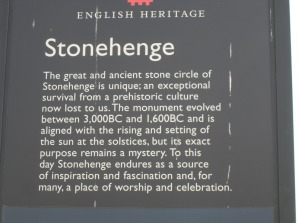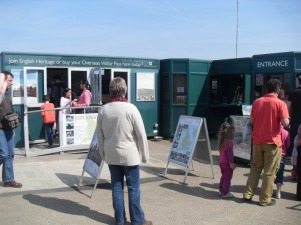A part of English Heritage
Stonehenge is managed by English Heritage. The commission has the goal to conserve and enhance the historic environment, give public access to the sites and provide learning experiences that help visitors understand the past. Partly funded by the government, with contributions from entrance fees and other revenue generated at the sites, English Heritage uses this money to restore historic sites.
All English Heritage sites form a network, and visitors are encouraged to become members of English Heritage. At Stonehenge, English Heritage employees have their office and information desk right next to the main entrance, and on busy days, they will go around and approach visitors directly with the offer of signing up. Several A-Boards also advertise English Heritage, and suggest that visitors “Join Today!” They offer various forms of membership, from yearly membership to lifelong membership for adults, couples, seniors and students. Foreign visitors are targeted with passes valid for several days, as they might be interested in visiting more than one English Heritage site in the short amount of time it is assumed they are on holiday for.
The normal, adult year-long membership costs £44, however, this gives free access to over 400 English Heritage sites in England such as abbeys, castles and stately homes, and up to six children under 19 years of age can accompany paying adults for free.
The summary of Stonehenge’s Management Plan from 2009 lists that within nine years some aims have been achieved which were set in 2000. This included getting farmers in the area around Stonehenge and on National Trust property to return arable land to grassland, and so avoid damage to monuments such as burial mounds, as well as avoiding to accidently destroy prehistoric artifacts uncovered through plough damage. This also improved the landscape, and returned it to grassland and pasture as it might have appeared when Stonehenge was first built over 4000 years ago in the Neolithic Age. This gives visitors an experience which is perceived as more authentic, than the ploughed fields around the stone circle would have been.
Already in 2000, plans were made for a major re-development. It was planned to take the A303 underground where it runs alongside Stonehenge, and re-grass the area now covered by the road, as well as close off the A344. This would have returned the landscape to a more “natural” setting, and given the visitors unobstructed views over the Salisbury Plain. Although the government decided against this plan in 2007, the current management plan contains the aim to close the A344 and review the situation of the A303 and the tunnel idea. This is especially important, as the Stonehenge World Heritage Site was inscribed into UNESCO’s list as a cultural landscape site. This clearly shows that the landscape surrounding Stonehenge and the nearby burial mounds and barrows are as important, as the archaeological sites themselves.
Next to this, English Heritage had also identified the need for a new and bigger visitor centre, which would have been a little further away from the site than the current one. However, when the road development plans were put on halt, it also brought the planning of the visitor centre to a stop.
The management plan states that new signposts and panels have been put up, however there are no such explanatory panels at the actual Stonehenge site. What was improved was the English Heritage homepage for Stonehenge, and the educational content of the website. This now includes a 360° Panorama, background information and interpretation of Stonehenge, as well as resources for schools and an interactive map, day planner and a gallery of visitor photos. Although this information is impressive and highly educational for travellers wishing to visit Stonehenge, it does not help the understanding of the site on the actual day of the visit as these resources are not yet available at the visitor centre. Therefore, visitors would either have to look it up before the trip to Amesbury, or check for facts after they have visited the stone circle.
One major aspect English Heritage management has identified is the need for a larger visitor centre. With 900,000 visitors per year, the old structure from 1968 is stretching its capacity limits. They also clearly acknowledge that they might not be living up to visitor expectations at the moment, and that interpretation and access will have to be improved. Other aims include the removal of scrubs and woodland from the archaeological sites surrounding Stonehenge, and the need to monitor the impact of the roads on the stone circle, especially that of the A303, although this is clearly marked as a long-term goal.
All English Heritage sites form a network, and visitors are encouraged to become members of English Heritage. At Stonehenge, English Heritage employees have their office and information desk right next to the main entrance, and on busy days, they will go around and approach visitors directly with the offer of signing up. Several A-Boards also advertise English Heritage, and suggest that visitors “Join Today!” They offer various forms of membership, from yearly membership to lifelong membership for adults, couples, seniors and students. Foreign visitors are targeted with passes valid for several days, as they might be interested in visiting more than one English Heritage site in the short amount of time it is assumed they are on holiday for.
The normal, adult year-long membership costs £44, however, this gives free access to over 400 English Heritage sites in England such as abbeys, castles and stately homes, and up to six children under 19 years of age can accompany paying adults for free.
The summary of Stonehenge’s Management Plan from 2009 lists that within nine years some aims have been achieved which were set in 2000. This included getting farmers in the area around Stonehenge and on National Trust property to return arable land to grassland, and so avoid damage to monuments such as burial mounds, as well as avoiding to accidently destroy prehistoric artifacts uncovered through plough damage. This also improved the landscape, and returned it to grassland and pasture as it might have appeared when Stonehenge was first built over 4000 years ago in the Neolithic Age. This gives visitors an experience which is perceived as more authentic, than the ploughed fields around the stone circle would have been.
Already in 2000, plans were made for a major re-development. It was planned to take the A303 underground where it runs alongside Stonehenge, and re-grass the area now covered by the road, as well as close off the A344. This would have returned the landscape to a more “natural” setting, and given the visitors unobstructed views over the Salisbury Plain. Although the government decided against this plan in 2007, the current management plan contains the aim to close the A344 and review the situation of the A303 and the tunnel idea. This is especially important, as the Stonehenge World Heritage Site was inscribed into UNESCO’s list as a cultural landscape site. This clearly shows that the landscape surrounding Stonehenge and the nearby burial mounds and barrows are as important, as the archaeological sites themselves.
Next to this, English Heritage had also identified the need for a new and bigger visitor centre, which would have been a little further away from the site than the current one. However, when the road development plans were put on halt, it also brought the planning of the visitor centre to a stop.
The management plan states that new signposts and panels have been put up, however there are no such explanatory panels at the actual Stonehenge site. What was improved was the English Heritage homepage for Stonehenge, and the educational content of the website. This now includes a 360° Panorama, background information and interpretation of Stonehenge, as well as resources for schools and an interactive map, day planner and a gallery of visitor photos. Although this information is impressive and highly educational for travellers wishing to visit Stonehenge, it does not help the understanding of the site on the actual day of the visit as these resources are not yet available at the visitor centre. Therefore, visitors would either have to look it up before the trip to Amesbury, or check for facts after they have visited the stone circle.
One major aspect English Heritage management has identified is the need for a larger visitor centre. With 900,000 visitors per year, the old structure from 1968 is stretching its capacity limits. They also clearly acknowledge that they might not be living up to visitor expectations at the moment, and that interpretation and access will have to be improved. Other aims include the removal of scrubs and woodland from the archaeological sites surrounding Stonehenge, and the need to monitor the impact of the roads on the stone circle, especially that of the A303, although this is clearly marked as a long-term goal.




